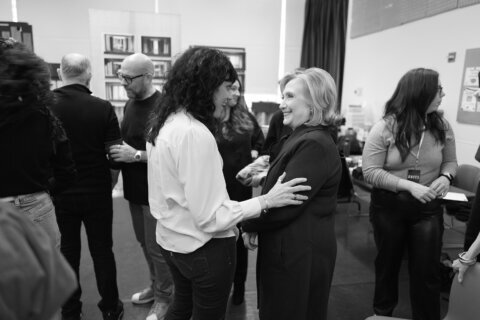WASHINGTON — Three-and-a-half-year-old Emma Quick runs into a room filled with instruments spread out across the floor. Her energy and excitement cause her blonde pig tails to bounce above her blue polka-dot shirt.
“Are you ready to make some music?” asks 24-year-old Katie Myers, whose enthusiasm rivals Emma’s.
“Yeah!” Emma quickly responds.
Myers grabs her guitar and launches into a “hello” song; Emma picks up a set of red sticks and begins to play along. The two continue their roles until Myers stops the singing and asks a question.
“Emma, who should we sing to?”
Myers asks another time, then another.
“What’s your name?”
After flashing several smiles, Emma responds to Myers’ satisfaction, and the two return to making music.
Despite what it looks like, Emma’s not there to learn instruments, songs or notes — that’s just a bonus. Emma has Down syndrome and meets with Myers for weekly music therapy sessions to work on her speech, fine-motor and gross-motor skills.
“Some of [music therapy], yes, is music skills, but it’s mostly using the music activities to develop other skills,” says Myers, a therapist with Levine Music.
“Sometimes teaching them short songs on the piano or teaching them musical skills is achieving one of their goals, but the focus is not on the musical skills themselves.”
Music Therapy Hits the Right Note in Health Care
Music therapy has been a profession since World War I, when musicians would go to veterans’ hospitals and play for the wounded patients, says Leanne Belasco, director of music therapy at Levine Music.
“The doctors and nurses observed there was a real positive change that came about from the presence of musicians with the patients,” Belasco says.
Since then, the profession has grown immensely, and its application has expanded to help people in all stages of life — from premature infants to patients in hospice, from children on the autism spectrum to adults who have suffered a stroke.
Al Bumanis, director of communications for theAmerican Music Therapy Association, estimates that 1 to 2 million people seek music therapy as a treatment tool to address non-musical goals each year; 73 colleges and universities offer music therapy as a degree program.
How does music help patients with a wide range of diagnoses and needs? Bumanis says music works as a vehicle to deliver treatment exercises patients need to progress.
For Emma, Myers uses a drum, one of Emma’s favorite instruments, to prompt Emma to say words on beat. Speech is a main focus of Emma’s therapy.
When it’s time for Emma to work on fine-motor skills, such as moving her fingers quickly and individually, Myers has Emma “tickle” the drum or play the piano.
“She has a hard time playing and saying words at the same time, so [we’re] working on getting that coordination together on the piano,” Myers says.
Asking Emma how she’s feeling during the “hello” song teaches her to recognize and express her emotions. It also teaches Emma to wait her turn and listen to Myers when she tells Emma how she feels during the song.
“That’s what’s helpful about having music as a tool. We can use it in so many different ways to do what we need to do with it,” Myers says.
Emma’s mother, Cynthia Smith, says she’s noticed “drastic differences” in Emma since she began music therapy in January.
“She’s more expressive and precise with her words and pronunciation,” says Smith, of Bethesda, Md. “She’s putting together concepts and articulating her ideas clearer.”
Emma, who a few months ago was not stringing together full sentences, now does so — often through music. Smith says Emma looked out the window recently and when she saw rain drops, she began singing, “Rain, rain, go away.”
“Just putting tunes to directions, or putting tunes to phrases really helps [patients] associate a lot of things … I think that helps with the memory aspect of things,” Myers says.
Working with Newborns, Vets and the Aging Population
American Music Therapy Association’s Bumanis says music therapy is used in neonatal intensive care units throughout the country to help infants who aren’t thriving. Research shows soothing music encourages infants to suck, allowing them to take in more food, he says.
“I think mothers have known this for centuries … infants tend to thrive more, get more nutrition when lullabies are playing,” he says.
Veterans suffering from war injuries — emotional and physical — also use music therapy to help them recover.
“Music is a way to reach them and a way to affect different areas of the brain to relearn skills … and emotional issues that come up,” says Bumanis, who’s been a music therapist for 30 years.
Levine Music’s Belasco says, “We’ve seen music provide a tool for them to really get their feelings out or to really talk about something that they might not be comfortable with in another setting … we might use music to work on emotional expression and management of difficult emotions, like frustration or anxiety or anger.”
Music therapy helps stroke patients regain their speech. Therapists might start out humming with the patient. When some progress is made, they may begin to sing words until the patient is able to vocalize again.
When the music stops, the vocal ability is still there.
“Eventually, when we take away the music, the patient’s able to transfer those skills,” Bumanis says.
For older populations, music is used as a reality-based activity to keep patients present.
“A group playing together or singing together, you have to be in the here and now to participate,” Bumanis says.
Those in the later stages of Alzheimer’s or dementia can learn different drum or rhythm patterns in group sessions with family members and caregivers. Bumanis says this gives them a form of communication and expression they can share with others.
In the later stages of life, music therapy is not as rehabilitative as it is for younger populations, but Bumanis says it’s a “quality-of-life enhancer.”
“The goals are not to create a dancer or a singer. It’s to help the person, in a sense, rewire the brain.”
Keeping a 3-year-old’s attention for 30 minutes is a challenge, but after singing and playing guitar, drums, sticks and piano, Emma’s music therapy session comes to a close. It was all fun and games to her, but it was also hard, challenging work.
Myers picks up her guitar once again and starts singing a goodbye song to close the session.
“Well well, it’s time to say goodbye. It’s been fun but it’s time to say …”
“Bye,” Emma finishes.







